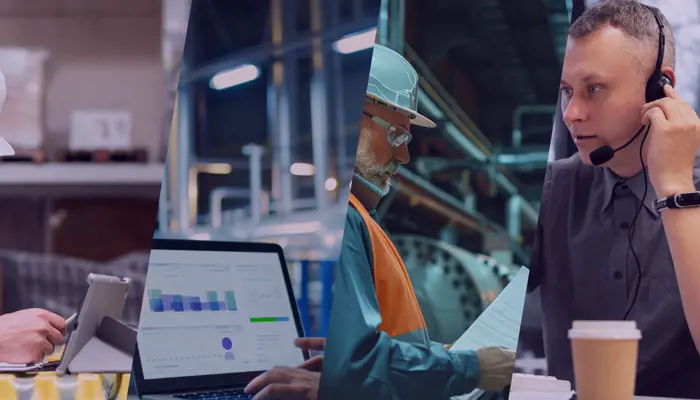
Dyer history: boosting efficiency with asset tracking and process management
Dyer Engineering, a UK manufacturer, started using RTLS technology through asset tracking, expanding into COVID-19 contact tracing, and later optimising their production process with a customised process management service. This highlights the versatility of the system and the adaptability of indoor location applications to various industrial scenarios.
- Indoor location applications provide solutions for various industrial needs
- Dyer Engineering leveraged RTLS potential through asset tracking, contact tracing and production process optimisation
- Key benefits include reduced lead times, increased liquidity and improved production scheduling
In the ever-evolving landscape of technological advancements, scalability and flexibility of solutions play a key role in shaping the success of industries. Real-Time Location Systems (RTLS) have emerged as a leading example, offering solutions that not only meet current needs but also expand to address evolving challenges. A remarkable illustration of this scalability is exemplified by a case study in the manufacturing sector, Dyer Engineering.
Who is Dyer Engineering and what was their challenge
Dyer Engineering is a UK manufacturer of metal components and fabricated and welded structures used in multiple industries including automotive, oil, gas, rail, defence, renewables and mining. It supplies its products both locally and globally since 1977. Dyer Engineering is headquartered in County Durham with two running manufacturing facilities, three miles apart one from the other, whose combined footprint is around 9.200 square metres.
Dyer Engineering has been using the ThinkIN technology for approximately 3 years. The project started thanks to a Digital Catapult initial funding that helped in kicking off activities. All Dyer facilities were infrastructured with Quuppa RTLS, with a localisation accuracy that was varying depending on the venue and location. ThinkIN was integrated with the ERP used by Dyer Engineering. The integration was both to read data, as well as to return data, e.g. location data on the assets position.
The initial focus of the project was on the tracking of the Job Cards moving around the shop floor with the main objective of:
- reducing the time spent in searching assets
- preventively identify anomalies such as a job card stalled in the process
- possibly coordinate some of the activities on the shop floor.
The project expansion
An initial service expansion happened during the COVID pandemic, when it was important to trace contacts among workers and enforce specific health & safety internal policies. This proved to be key in order not only to preserve operations and business continuity, but also to maintain a good relation with customers looking for suppliers that were investing on measures to mitigate the risks due to the COVID pandemic..
Given the existing Quuppa RTLS infrastructure, adding a new service was rather straight and fast. A set of badges were provided to workers during their working shifts and a contact tracing application was developed to properly manage risks due to work organisation, possible outbreaks. Thanks to the combination of an existing RTLS and a location intelligence service platform the overall implementation was taking approx. 1 month.
After a few years, Dyer Engineering expressed the interest to use the technology to also support the movement of Work In Progress (WIPs). In a production process characterised by the constant movement of semi finished goods by workers, this was considered to be key in order to boost efficiency. Therefore, during 2022 we started the implementation of an application to monitor the entire production process, identifying deviations and recommending actions to take. We have completed the full integration with their ERP software and developed a dedicated application to visualise the progress of processes and identify an initial set of anomalies.
The overall objective of the system was to provide a simplified MES, able to integrate with the ERP and reduce the overall number of WIPs moving in the shopfloor.
Being able to move the right things, at the right time, to the right place is the overall objective that will drive value for Dyer Engineering.
Richard Larder
Head of Digital Innovation
Dyer Engineering
The key benefits that we expect to obtain are related to:
- reduced lead time: more transparency on processes and better utilisation of resources should lead to a reduced lead time and higher productivity.
- increase in liquidity due to reduced WIPs on the shop floor: WIPs can only be invoiced when shipped. Having less WIPs moving is linked to a higher liquidity thanks to reduced lead time.
- better modelling of production and scheduling: the average lead time is approx. 4 weeks (although this can vary depending on the product). Being able to link the production hours planned for it to the time on the shop floor will allow for a better scheduling of activities.
- modelling and quantifying the impact of disruptions: when this is possible it becomes
easier to fast track WIPs and charge for it. This eventually translates into additional revenue streams thanks to surcharging.
To sum up, thanks to its expertise, ThinkIN developed an integrated approach from asset tracking to process management, highlighting the flexibility, modularity and scalability of RTLS solutions as well as their applicability to multiple use cases. Dyer Engineering’s success story is an emblematic example of the potential of RTLS in an industrial setting. With a strong commitment to innovation, Dyer Engineering has demonstrated its readiness to explore new avenues and embrace the opportunities offered by technology. What about you? Contact us to boost efficiency within your business!

